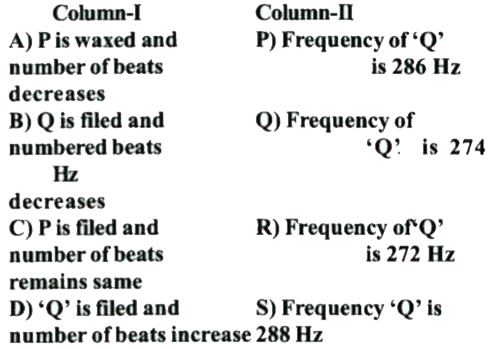A tuning fork A of frequency f gives 5 beats/s with a tuning fork B of frequency 512 Hz. If on filing A, the number of beats remains same, then find the value of f.
The correct Answer is:507 Hz
To solve the problem, we need to determine the frequency f of tuning fork A, given that it produces 5 beats per second with tuning fork B, which has a frequency of 512 Hz.
1. Understanding Beats: The number of beats per second is given by the absolute difference in frequencies of the two tuning forks. Thus, we can write:
|f−512|=5
2. Setting Up the Equations: This absolute value equation leads to two possible cases:
- Case 1: f−512=5
- Case 2: f−512=−5
3. Solving Case 1:
- From Case 1:
f−512=5⟹f=512+5=517 Hz
4. Solving Case 2:
- From Case 2:
f−512=−5⟹f=512−5=507 Hz
5. Analyzing the Effect of Filing: The problem states that when tuning fork A is filed, the number of beats remains the same (5 beats/s). Filing increases the frequency of A.
- If f=517 Hz, filing it would increase the frequency further, resulting in a greater beat frequency than 5 beats/s.
- If f=507 Hz, filing it would also increase its frequency, but it could still maintain a beat frequency of 5 beats/s if it increases to 512 Hz (the frequency of fork B).
6. Conclusion: The only value of f that allows the beat frequency to remain constant at 5 beats/s after filing is:
f=507 Hz
Final Answer:
The value of f is 507 Hz.
|f−512|=5
- Case 1: f−512=5
- Case 2: f−512=−5
- From Case 1:
f−512=5⟹f=512+5=517 Hz
- From Case 2:
f−512=−5⟹f=512−5=507 Hz
- If f=517 Hz, filing it would increase the frequency further, resulting in a greater beat frequency than 5 beats/s.
- If f=507 Hz, filing it would also increase its frequency, but it could still maintain a beat frequency of 5 beats/s if it increases to 512 Hz (the frequency of fork B).
f=507 Hz
The value of f is 507 Hz.
Topper's Solved these Questions
- BOOK - MODERN PUBLICATIONCHAPTER - WAVESEXERCISE - CONCEPTUAL QUESTIONS25videos
WAVES
- BOOK - MODERN PUBLICATIONCHAPTER - WAVESEXERCISE - NCERT TEXTBOOK EXERCISES21videos
WAVES
- BOOK - MODERN PUBLICATIONCHAPTER - WAVESEXERCISE - PROBLEM9videos
WAVES
- BOOK - MODERN PUBLICATIONCHAPTER - UNITS AND MEASUREMENTEXERCISE - CHAPTER PRACTICE TEST15videos
UNITS AND MEASUREMENT
- BOOK - MODERN PUBLICATIONCHAPTER - WORK, ENERGY AND POWER EXERCISE - Chapter Practice Test16videos
WORK, ENERGY AND POWER
Similar Questions
A tuning fork of unknown frequency gives 4beats with a tuning fork of frequency 310 Hz. It gives the same number of beats on filing. Find the unknown frequency.
View SolutionA tuning fork A produces 4 beat/s with another tuning fork B of frequency 320 Hz. On filing one of the prongs of A, 4 beat/s are again heard when sounded with the same fork B. Then, the frequency of the fork A before filing is
View Solution
Knowledge Check
- Question 1 - Select One
A tuning fork 'P' of frequency 280Hz produces 6 beats/s with unknown tuning fork 'Q'
 AABCDQRSRBABCDQRQPCABCDP.QQ.RR.SPDABCDR.SQ.RSR
AABCDQRSRBABCDQRQPCABCDP.QQ.RR.SPDABCDR.SQ.RSR - Question 2 - Select One
A tuning fork A produces 4 beats/sec with another tuning fork B of frequency 320 Hz . On filing the fork A , 4 beats/sec are again heard. The frequency of fork A , after filing is
A324 HzB320 HzC316 HzD314 Hz - Question 3 - Select One
A tuning fork sounded together with a tuning fork of frequency 256 emits two beats. On loading the tuning fork of frequency 256, the number of beats heard are 1 per second. The frequency of tuning fork is
A257B258C256D254
A tuning fork A produces 5 beats/sec with another tuning fork B of frequency 256 Hz. If tuning fork A produces 1 beats/sec with some other tuning fork C of frequency 250 Hz, then calculate the frequency of fork A.
View SolutionA tuning fork gives 5 beats with another tuning fork of frequency 100 Hz . When the first tuning fork is loaded with wax, then the number of beats remains unchanged, then what will be the frequency of the first tuning fork
View SolutionA tuning fork A produces 4 beats/second with another tuning fork of frequency 246 Hz. When the prongs of A are filed a little, the number of beats heard is 6 per second. What is the original frequency of the fork A?
View SolutionA tuning fork A produces 4 beats s−1 with another tuning fork B of frequency 320Hz. ON filing one of the prongs of A, 4 beats s−1 are again heard when sounded with the same fork B. Then the frequency of the fork a before filling is
View SolutionA tuning fork of unknown frequency x, produces 5 beats per second with a tuning fork of frequency of 250 Hz. The produces 10 beats/second with another tuning fork frequency 265 Hz. The unknow frequency is
View Solution

